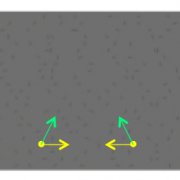Euclidean plane geometry builds on intuitions so compelling that they were believed for centuries to have the force of logical necessity. Where do these intuitions begin, and how are they elaborated over development? Behavioral studies of human infants, preschool children, and older children up to adolescence are shedding light both on abstract but limited geometric representations that emerge in the first year of life, on the more explicit representations that emerge from 2 to 6 years as children master spatial symbols such as maps, and on the intuitions relating distances to angles that children begin to articulate between 6 and 12 years. Computational models of this process explore the role of mental simulation in the emergence of these intuitions.
Development of Intelligence
 Understanding the development of intelligence in a human infant is a key project of CBMM. This project engages the fundamental tradeoff between nature and nurture, or priors and data, and ultimately the origin of priors—how constraints are selected by evolution, encoded in genes, and instantiated in genetically wired brain circuits.
Understanding the development of intelligence in a human infant is a key project of CBMM. This project engages the fundamental tradeoff between nature and nurture, or priors and data, and ultimately the origin of priors—how constraints are selected by evolution, encoded in genes, and instantiated in genetically wired brain circuits.
This project also represents a novel developmental approach to building human-like artificial intelligence systems and comprehensive computational models of human cognitive architecture. Instead of branching out from a single area of adult human intelligence, we start with an integrated cognitive model of multiple core capacities in the young child’s mind, along with a set of developmental or learning mechanisms for scaling up to an adult model.

